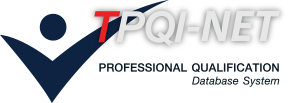หน่วยสมรรถนะ
Apply systems engineering procedures to airworthiness engineering design.
สาขาวิชาชีพการบิน
รายละเอียดหน่วยสมรรถนะ
| 1. รหัสหน่วยสมรรถนะ | AVT-WZJY-244A |
| 2. ชื่อหน่วยสมรรถนะ | Apply systems engineering procedures to airworthiness engineering design. |
| 3. ทบทวนครั้งที่ | / |
| 4. สร้างใหม่ |
|
ปรับปรุง |
|
| 5. สำหรับชื่ออาชีพและรหัสอาชีพ (Occupational Classification) | |
|
7232 Aircraft engine mechanics and fitters |
|
| 6. คำอธิบายหน่วยสมรรถนะ (Description of Unit of Competency) | |
| Systems engineering procedures are applied in establishing management procedures engineering design projects related to the design of complex systems that require integration of subsystems and / or components of a multidisciplinary engineering team. Management processes can refer to all design stages and may include the development of software systems. In the stages of production and management life cycle, the output data systems engineering design phase can be used in the implementation of procedures for configuration management (CM) and / or to support the implementation of logistical support integrated (ILS) where justified by the size and complexity of the system or when required by contract. | |
| 7. สำหรับระดับคุณวุฒิ |
| 1 | 2 | 3 | 4 | 5 | 6 | 7 | 8 |
|---|---|---|---|---|---|---|---|
| 8. กลุ่มอาชีพ (Sector) | |
| 10 Aircraft Mechanics | |
| 9. ชื่ออาชีพและรหัสอาชีพอื่นที่หน่วยสมรรถนะนี้สามารถใช้ได้ (ถ้ามี) | |
| 101 Aircraft Maintenance: Airplane102 Aircraft Maintenance: Helicopter103 Aircraft Maintenance: Avionic | |
| 10. ข้อกำหนดหรือกฎระเบียบที่เกี่ยวข้อง (Licensing or Regulation Related) (ถ้ามี) | |
| ICAO Doc 7192 / EASA Part 66 | |
| 11. สมรรถนะย่อยและเกณฑ์การปฏิบัติงาน (Elements and Performance Criteria) |
| หน่วยสมรรถนะย่อย (EOC) | เกณฑ์ในการปฏิบัติงาน (Performance Criteria) | รหัส PC (ตามเล่มมาตรฐาน) |
รหัส PC (จากระบบ) |
|---|---|---|---|
| 101511.01 Document system requirements and perform functional analysis. |
101511.01.01 Identify and document customer or contractual system requirements and relevant regulatory requirements and set up a systems engineering team to allocate responsibilities. |
101511.01.01 | 199476 |
| 101511.01 Document system requirements and perform functional analysis. |
101511.01.02 Review and develop functional analysis outcomes against requirements and revise where necessary. |
101511.01.02 | 199477 |
| 101511.02 Manage preliminary and detail design activities. |
101511.02.01 Coordinate the development of performance specifications for the system and components. |
101511.02.01 | 199482 |
| 101511.02 Manage preliminary and detail design activities. |
101511.02.02 Coordinate the development of item, software specifications, engineering drawings, process and material specifications. |
101511.02.02 | 199483 |
| 101511.03 Provide oversight of production and delivery for life-cycle management of the system, components and software. |
101511.03.01 Apply product review and verification procedures and initiate action to remedy design or production deficiencies, Where there is a contractual requirement for the application of CM, provide technical data package and define the configuration items and baselines. |
101511.03.01 | 199494 |
| 101511.03 Provide oversight of production and delivery for life-cycle management of the system, components and software. |
101511.03.02 Where there is a contractual requirement for ILS, provide the technical data package and data required for the development of the relevant ILS plans. Where there is no contractual requirements relating to life cycle management, deliver the package of technical data and develop procedures for managing system configuration, system components and software that meet the relevant regulatory requirements. |
101511.03.02 | 199495 |
| 12. ความรู้และทักษะก่อนหน้าที่จำเป็น (Pre-requisite Skill & Knowledge) | |
|
101401 Use computers in aviation maintenance-related integrated logistic support activities. |
|
| 13. ทักษะและความรู้ที่ต้องการ (Required Skills and Knowledge) | |
|
(ก) ความต้องการด้านทักษะ N/A (ข) ความต้องการด้านความรู้ N/A |
|
| 14. หลักฐานที่ต้องการ (Evidence Guide) | |
|
(a) Performance Evidence (b) Knowledge Evidence |
|
| 15. ขอบเขต (Range Statement) | |||||||||||||||
|
(a) Recommendation
(b) Description |
|||||||||||||||
| 16. หน่วยสมรรถนะร่วม (ถ้ามี) | |
| N/A | |
| 17. อุตสาหกรรมร่วม/กลุ่มอาชีพร่วม (ถ้ามี) | |
| N/A | |
| 18. รายละเอียดกระบวนการและวิธีการประเมิน (Assessment Description and Procedure) | |
|
The assessment are based on combination of paper exams, interviewing, and practical demonstrations depending on the assessors’ judgement.Evidence required to demonstrate competency in this unit should be of interest and meet all requirements of the elements and performance criteria under the specified conditions assessment, and should include: |
|
